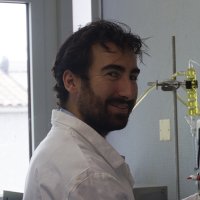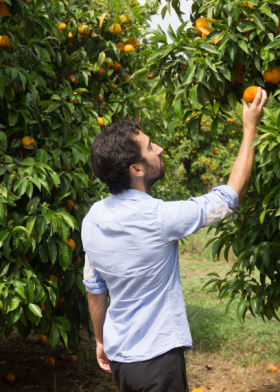
Food, Global Health Reading time 5 min
Vincent Ferrer, Aromawork Orange
Published on 04 July 2022
After studying science in Toulouse and training as an agricultural engineer in Dijon, Vincent Ferrer is ready to start a thesis in Corsica, between the Monte Castello d'Osari mountain and the Tyrrhenian Sea, in the Genetic Improvement and Adaptation of Mediterranean and Tropical Plants unit. This thesis will be carried out within the framework of a Cifre scheme that associates the Cointreau company and INRAE for the benefit of science. Started in June 2019, it focuses on orange aromas, but not just any. Specifically, those that give the brand's triple-sec its unique flavour and fragrance.
Orange aromas: different tastes and smells
Fruity, zesty, floral, spicy... at the heart of Cointreau liqueur are the aromas of sweet orange peel, Citrus sinensis, and bitter orange, Citrus aurantium, in a skilful combination that must be mastered in order to guarantee the beverage's aromatic stability.
While the aromas of orange pulp have been widely studied, particularly from the point of view of their chemical composition, those of zests, which contain essential oils, have not. This is the field of research that Vincent has devoted himself to for the past three years. He is particularly interested in how different varieties, the nature of the rootstock, the stage of maturity of the fruit and the post-harvest treatment of the peel shape aromas.
Contributing to the development of partnership research
Vincent studied some 50 varieties of sweet oranges and as many sour oranges, selected in the Citrus Biological Resource Centre (CRB) and representative of the diversity of these species. Sensory, chemical and statistical analyses helped him understand the variability of their aromas.
The aromatic diversity of sweet oranges is low and their genetic diversity practically nil. It is worth remembering that their varietal diversity is based on natural spontaneous modifications that man has identified and maintained or even amplified through grafting. The aromatic diversity of sour oranges is lower than that of sweet oranges, but their genetic diversity is somewhat higher due to the integration of natural hybrids into the cohort of varieties resulting from the selection of natural mutants. In terms of flavour, these differences can probably be explained by intensive long-term selection of the orange, which is intended for consumption, whereas sour orange has been little selected and used for other purposes, such as rootstock.
Among the factors that influence fruit flavours, peel ripeness is important. Zests harvested at an early stage of development have a very different chemical composition from that of ripe fruit: they contain many oxygenated compounds, which in turn contain ester, aldehyde or alcohol groups, which play a key role in the aroma of zests. Whether they come from sweet orange or sour orange, these compounds lead to interesting, atypical aromas. Post-harvest treatment of the fruit also plays a key role and must be controlled and standardised to guarantee the aromatic quality of the peel.
Vincent Ferrer's vision of his work is very precise. "The main thing is to understand the parameters that cause variations in the composition of the flavours and to find a way to achieve consistency from different batches. In the long term, my work will be used to give indications to all the operators in the raw material supply chain (producers and buyers): give preference to this or that rootstock, harvest at the right time, process under certain conditions, etc. In a word, specifications”.
Behind the closed doors of the Cointreau distillery, the master distiller Carole Quinton, who assembles batches of orange peels from different countries around the world, has already begun testing.
In the Garden of the Hesperides

On the aroma side, Vincent also devotes part of his time to a mouth-watering fruit resulting from the crossing of a clementine and an orange, the tangor. This is more exploratory work in which he is interested in the fate of the orange aroma in the zests of these hybrids: can it be passed on to the offspring? How will it be distributed there? What are the genetic carriers of the aroma of the zests of essential oils? The goal is to understand the genetic architecture of the orange aroma as a result of the genetic mixing generated by the crossing.
Among the progeny, some hybrids with aroma profiles close to that of the orange were identified. Unfortunately, this work did not establish a link between the composition of these hybrids and the orange aroma profile. This is certainly due to the great complexity of the orange aroma, which involves a large number of compounds that current analytical methods do not detect because they are too few. However, chromosomal regions responsible for the production of compounds with significant aromatic activity have been identified. These regions could thus be used in the future to carry out varietal selection programmes through early selection of the progeny. This will save time and money, since it takes no less than five years for a tree to bear its first fruit.
Of numbers and letters
Scientific spirit, entrepreneurial spirit
The Cifre program has become increasingly attractive since its creation in 1981. Some 1,387 Cifre grants were awarded in 2019 (for 16,000 students enrolled in the first year of their PhD) and the goal is to award 2,150 by 2027, an increase of 55% (source: Ministry of Higher Education, Research and Innovation-MESRI). At INRAE, 54 Cifre PhD students were accepted in 2021, bringing the number of Cifre theses in progress at the Institute to 160. Moreover, Vincent, who happened to cross paths with INRAE scientists in his training as an agronomist, was quick to take note of INRAE’s Cifre thesis offer at San Giuliano.
Industrial contracts that provide training through research are now widely recognised for their great worth. And Vincent Ferrer couldn’t agree more. What he appreciates in particular is the "real life" aspect, with one foot in research and the other in the private sector, enabling him to benefit from both. Moreover, it is gratifying to transfer and enhance academic knowledge for the benefit of the business world. The starting salary is quite attractive and Vincent doesn’t mind earning a little more than the average PhD student who, in his words, “earns too little considering the studies and the work they do". In 2018, data from the Ministry of Higher Education, Research and Innovation reported a minimum monthly salary of €1,957 gross (i.e., €23,484 gross per year) for Cifre doctoral students compared to €1,758 gross for contractual doctoral students in public higher education or research institutions. Vincent is already thinking of what lies ahead, confident that he will be able to get a job quickly after his thesis. Buoyed by the momentum behind the program, he is confident that "90% of Cifre PhDs find a job within six months" (2020 data, source MESRI). More than an opportunity, it's a springboard to the future.
And the future looks bright, both in the long and short terms. For now, Vincent Ferrer is getting ready to submit his thesis on July 11 of this year. A few more weeks will allow him to fine-tune his presentation in preparation for the big day. And what better way to celebrate the result than a cake à l’orange?
Industrial agreement for training through research (Cifre)
The Cifre scheme involves three partners:
- A company. The company recruits a graduate with a master's degree on a three-year fixed-term contract, or even a permanent contract, and entrusts him or her with research that is the subject of their thesis. The company receives an annual grant of €14,000 for three years from the National Association for Research and Technology (ANRT), which manages Cifre agreements on behalf of the Ministry of Higher Education, Research and Innovation.
- An academic research laboratory. It supervises the work of the employee/doctoral student, who as such is registered in the doctoral school to which the laboratory is affiliated.
- A doctoral student. He or she devotes 100% of their time, split between the company and the academic laboratory, to research.
This is a winning combination whose purpose is threefold: strengthen exchanges between public research laboratories and the socio-economic world; help PhD candidates get jobs in companies; and foster innovation within companies set up in France.
Since 1981, the Cifre program has brought together 9,000 companies, more than 4,000 laboratories and 25,400 doctoral students around research projects. Present in all regions of France, these programmes cover all sectors of activity with large companies as well as with small and medium-sized enterprises (SMEs) or intermediate-sized companies. Associations and local authorities are also eligible.
Mini-CV
28 years old
Since 2019: PhD - Study of the heredity and variation factors of the yield, composition and aromatic properties of the essential oils of sweet orange (Citrus sinensis (L.) Osbeck) and sour orange (C. aurantium L.), University of Corsica.
2018: Agricultural engineer, AgroSup Dijon.
2012: French Baccalauréat, Toulouse.
|
Ferrer V. et al. Influence of the Rootstock and the Ploidy Level of the Scion and the Rootstock on Sweet Orange (Citrus sinensis) Peel Essential Oil Yield, Composition and Aromatic Properties. Agriculture 2022, 12, 214. Ferrer V. et al. Intercultivar Diversity of Sour Orange (Citrus aurantium L.) Based on Genetic Markers, Phenotypic Characteristics, Aromatic Compounds and Sensorial Analysis. Agronomy 2021, 11, 1084. |
